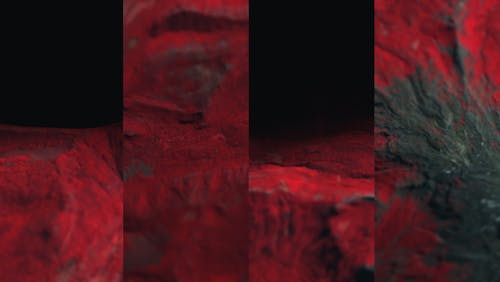In conversation: Mark IJzerman & Sébastien Robert
Mark IJzerman & Sébastien Robert were originally due to debut their collaborative audiovisual work ‘As Above, So Below’ at Rewire 2020, so we’re very excited for them to bring this show to Paard on 30th October for the 18th edition of Rewire x Korzo. We asked Sébastien and Mark to discuss with one another their individual backgrounds, how they came to work together on this project, and the effect that each of their areas of expertise had on the dynamics of this collaborative work. Find below the discussion in full, along with an extended teaser video of the audiovisual collaboration.
‘As Above, So Below’ explores the changing landscape of La Araucanía region in south-central Chile through live visuals and sound. This audiovisual performance probes into the dualism of man’s relationship with nature via sonic research made by Sébastien Robert, French sound artist, researcher and master student of The Hague’s ArtScience Interfaculty, and investigative visuals created from satellite imagery as well as microscopic and drone footage by Dutch media artist Mark IJzerman. During a residency in Chile they researched the logging industry that has been eroding the biodiversity of the region, causing disruption to the ecosystem. A special thanks also to Holly Dicker for coordinating the conversation.
→ https://player.vimeo.com/video/383987928
Sébastien Robert: You contacted me when you got selected for your V2 residency at Nabi Center in South Korea. You can elaborate about this.
Mark IJzerman: I applied to investigate the idea of an audio-photobook: still pictures and sounds in one medium. I was going to work with a Flemish photographer, but she dropped out last minute, so I was going to South Korea not knowing what material I would work with.
SR: And that’s the moment you contacted me. Six months earlier I was finishing my studies in business and economics at Hanyang University in Seoul. I spent four months there and had a lot of free time which I spent hiking in the mountains and photographing the landscape.
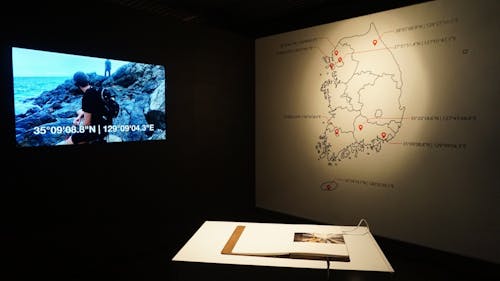
MI: I remember first reaching out to you asking you for tips. Then suddenly I remember being very stressed, boarding the plane and still not knowing what I was going to work on, so I got in touch about using your photos. So this results in our first collaboration: a book using pictures you printed with the G.P.S. coordinates on the side. There is a system in the book that plays the sounds of those exact places, which I captured six months later, so you get this very strange disconnection.
→ https://player.vimeo.com/video/249079052
SR: I think it’s interesting to highlight that I was on the visual side of the project and you were on the sound side. This is totally reversed right now.
MI: I hope we can keep doing projects like this, where we turn it around. Can you talk about your research and your current masters?
SR: After South Korea I decided to develop my own research project. I have a background in business and economics, but I really wanted to do something in the arts, because I was already producing music and photographs. I applied for a Master at the ArtScience Interfaculty between the Royal Academy of Art (KABK) and the Royal Conservatoire (KC) of The Hague. The project is called ‘You’re no Bird of Paradise’, basically researching indigenous rituals and music that are disappearing due to various reasons––technological, societal, ecological. Instead of only documenting them through sound recordings or film, I try to study in depth their sonic and visual characteristics. The aim is to pay tribute to these rituals by translating something that you cannot touch into something tangible by engraving or turning them into materials that will last forever, like immortal artefacts.
MI: Your research is interesting because it is not only about translating these immaterial, disappearing rituals into something tangible, it’s also about how you position yourself within these cultures in the process. This is also what your thesis is about, right?
SR: That’s true, I wrote this year a thesis about cultural appropriation in the field of sound art; how artists working with different indigenous groups position themselves, because it’s a delicate subject. When I go into the field, I try to understand what I can and cannot do. To give an example: my first field trip was to Cambodia to research healing music from a group of shamans. It was weird for me to go to Cambodia because Cambodia is a former French colony. When I arrived there, the shamans were super enthusiastic about me being able to record them––because this had never been done before. They only asked me for one thing: to send the recordings back. I asked, what do you mean by that? They said, no one should listen to this music, ever. I asked, why? And then they explained: this is shamanic music, which I could experience here, in this context. But playing or listening to this music outside of its original context is completely inappropriate. It can also put the listener at risk because of the various spirits entering someone’s body with the music. I asked if I could do something visual with the music. They said, do whatever you want so long as nobody listens to it. I found some graphic notation and translated their music into ASCII, which is an encoding system, and engraved all the notation onto sandstone (a stone native to Cambodia), as a way to materialise the music into an artefact.
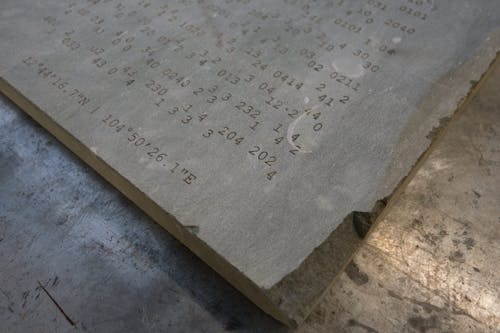
MI: Because you are studying Artscience––and my work is often in the realm of art and science––why do we think this combination matters in today’s world?
SR: Do you want to start?
MI: It’s become a bit of a cliche, but both art and science attempt to make sense of the world. They do this in very different ways, because science can only build on what was before, whereas art can give new views or cues into different ways of looking at something.
SR: You can present scientific data in a poetic way, but I don’t want to get into that way of thinking that art is only here to help visualise scientific data.. Let’s say that art helps to communicate in a different way, while science can help artists to ground their research in some concrete example or with serious data. Maybe you have more experience in that?
MI: When I work with researchers, I still have some difficulty translating my art project––or the questions that surround my art project––into questions that the researchers can actually do something with. Often the questions are partly aesthetic, partly technical, partly about certain issues, or how to interpret certain data. And if you’re not going to do infographics, let’s say, then it’s still hard to find a good reason to really work with them.
SR: Can you expand a bit more on your current research and artistic themes?
MI: I studied sound at Utrecht School of the Arts, and now I’ve been teaching there for more than eight years. A lot of my sound work has evolved around emergent processes. Coming from sound, there was always an interest in the environment. Two or three years ago I started to work with satellite imagery to bring locality and the environment into my performances. I find raising awareness about the ecological crisis important, though I am also aware that this is something which only in part can be done by art, I think. I don’t know how invested you are in making sense of this era of ecological crisis through our art, but I think it’s something we both don’t really dwell too much on.

SR: OK, let’s put this straight.. Before, I felt that unless you were someone like Olafur Eliasson, putting a gigantic block of ice in the middle of London, it doesn’t make sense to do anything––because it’s a lot about reach. More recently I’m realising, no, even if it’s a small thing, you can give a clear message with the arts. You can pass on ideas. You can show alternatives. You can open people’s minds.
MI: For me, I just realised that these topics are in a way at the core of my interests, though my interests have always been all over the place. Some of my work deals with more inter-planetary stuff, but it’s always relating back to the earth or the sound of the earth or the ecology of the earth.
SR: How do you become aware of an environment, visually and sonically?
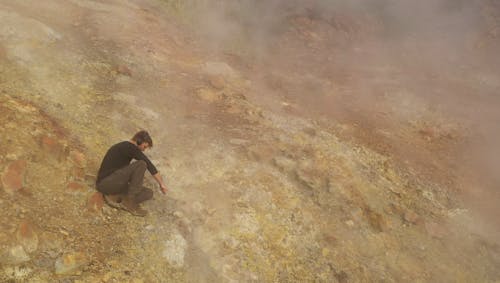
MI: What I noticed when we did the residency in the Chilean Andes together, that going out hiking and taking field recordings is also something meditative for me. You cannot be with too many other people to do that. For ‘As Above, So below’ I was mainly recording visual material, which is way more hands on than sounds. I was making these 3D models of tree bark, and I had to go around the tree with a camera, or making these microscopic recordings––really getting up close to certain materials, which is something completely different than setting up your recorder and giving into these moments. What is it like for you when you’re taking pictures or when you’re out recording?
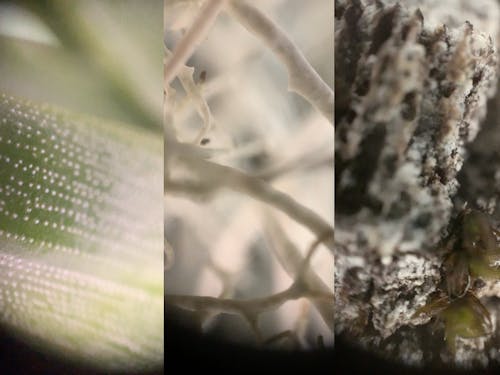
SR: I cannot do both photos and sound recording at the same time, I need to focus on one or the other.. When we were hiking together in the Valley of the Possible, we were exploring the surroundings. You were focusing on the visual side and I could focus on the sound. Perhaps we should give more context about the residency?
MI: In May 2019 we went to the Valley of the Possible for a residency in the Chilean Andes. You were applying with your ‘You’re no Bird of Paradise’ project, looking at Mapuche music, and I had been looking at satellite imagery of that area. I wanted to research deforestation from the point of view of how satellite imagery is very technocratic, from a very Western perspective. I wanted to relate that Western kind of thinking to the Mapuche––to their holistic vision, how they look at their relationship to the earth. It got very difficult because we were only there for one month, which is not really enough time to get to know the local communities well, though we got to work with them. The Valley is like a small world. The landscape is very diverse and you also have all kinds of different cultures there: the original colonists and the Mapuche people.
SR: The Chilean government is expropriating ancestral terrains from Mapuche.
MI: And in the media you see a lot of articles about Mapuche activists burning down plantations, blocking roads and setting vehicles on fire.
SR: The Mapuche don’t consider humans separate from nature. The whole economical situation is really disrupting their environment. It’s a big issue.
MI: There is a huge societal impact as well. People are driven into poverty and the eucalyptus trees commercially grown in the region are an invasive species, so they use a lot of water. The landscape is changing drastically, and this is something I wanted to look at from satellite imagery as well as from the ground. When we arrived we wanted to look very locally.
SR: This notion of locality is extremely important. While researching the Machis (Mapuche shamans) from the Netherlands, I thought they were disappearing because their entire ecosystem is being disrupted. But they had already been driven away a century before because of colonialism. That’s where this idea of hiking every day came from: to get a sense of the place, to understand what happened and what is going on now.
MI: And to focus on something very specific. If you want to tell a story, you have to start local. So we focused on two plantations close to where we were staying. One of them was a plot with eucalyptus trees and the other was already cut down.
SR: I think the challenge was to figure out how to approach this new territory sonically. I wanted to try something new, based on the Mapuche worldview.. In Mapudungun, the language spoken there, they do not make any difference between (natural) sound and (instrumental) music. Instead, they use many words making reference to the source of sound to describe the environment in which they are harmoniously living in. I felt like it would be nice to do something on the same level: record purely natural sounds and experiment with a trutruca, one of their instruments. I made recordings and with a small modular set up, I mingled both the natural and instrumental sounds into one body of work, so you can’t differentiate them anymore . It was my first time going somewhere and making sound based on a specific location.
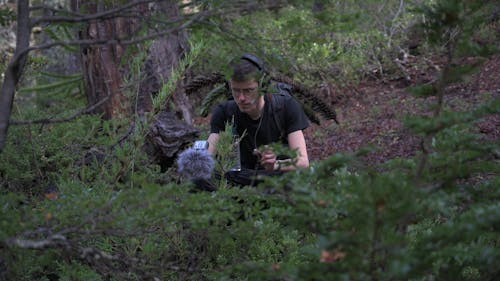
MI: Personally, I gathered a lot of satellite imagery before and after Chile. With drone footage you can clearly see a plot of land. On the microscopic level you can make comparisons, for example, between life forms on old-growth trees versus the abundance of organisms on eucalyptus trees. That’s how I gathered footage for “As Above, So Below”. Back in the Netherlands, I worked with Karin Staring, a student from the geomatics department at TU Delft (sponsored through the Crossing Parallels program). She helped me analyse these deforested plots. We also did some experiments using satellite imagery to figure out if certain trees were eucalyptus trees or old growth trees. Maybe it’s important to note that in the show we use these different kinds of footage and we obscure them––kind of like the way you obscure or transform your sonic material. The idea was to make the landscape an analog or a stand in for any landscape that might be scorched by human activity.
